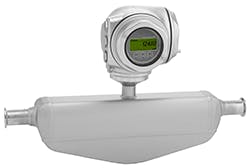Endress+Hauser updates its Proline 300 smart Coriolis and electromagnetic flowmeters for the hygienic industries. The compact hygienic 316L stainless-steel housings are designed to support an optional IP69 ingress protection rating, impervious to water ingress from high pressure wash-down. The sensors are designed according to ASME BPE, EHEDG and 3A standards, and reportedly provide full GMP compliance for sterile processes. They offer seamless integration into applications through a wide range of digital conductivity protocols including EtherNet/IP, according to the company.
The Proline Promass 300 Coriolis flowmeters have several surface finish options including stainless-mechanical or electropolished wetted parts and low delta ferrite content that fulfils stringent requirements for GMP design and cleanability. The design is optimized for cleaning and sterilization, offering full drainability even in near horizontal installations. The Proline Promass Coriolis mass flowmeters are available in 11 models ranging in sizes from 1/24 to 14 inches in diameter for measuring flows up to 100,000 tons per day. Proline Promag 300 flowmeters are available in two models in sizes from 1/12 to 24 inches for volume flows up to 42,000 gallons per minute. Both the Coriolis and electromagnetic flowmeters are available in models suitable for CIP/SIP processes in hygienic and sterile process applications.
Proline instruments connect to control systems via 4-20mA HART, PROFIBUS PA, FOUNDATION Fieldbus, Modbus, EtherNet/IP or PROFINET. Both families provide access to users via the device’s display, a web server, wireless LAN, handheld devices, asset management or process automation solutions, and Fieldbus protocol. Each provides fast commissioning, in-situ device verification during operation, continuous self-diagnostics and automatic on-board data storage.
Transmitter housings are available in aluminum and hygienic or severe service stainless steel. Each housing has a two-chamber system with a front-mounted compartment for connecting source power, wiring the analog and/or digital inputs and outputs, and accessing the Ethernet service access port or device display. The second chamber permits service technicians to access the electronics modules for repair functions while maintaining protection against dust and contamination.




